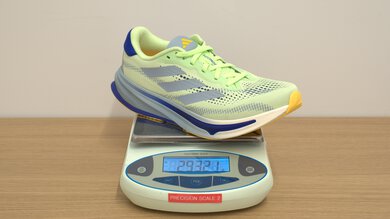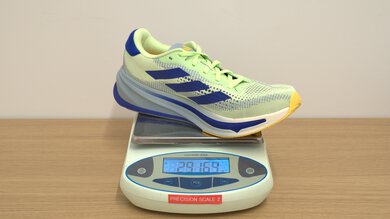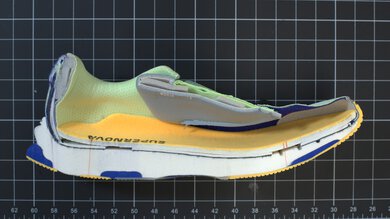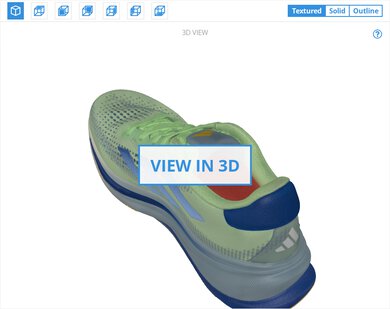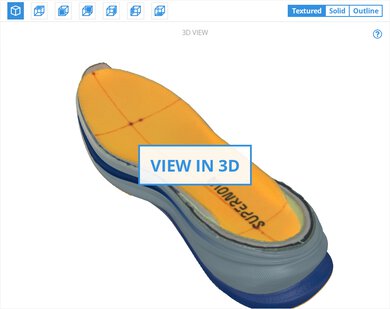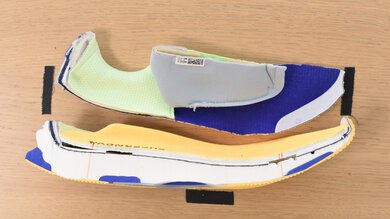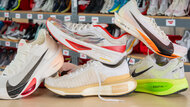The adidas Supernova Rise is a well-rounded daily trainer aimed at everyday runners, unlike the brand's elite Adizero lineup. While its midsole mostly uses EVA foam, it also features a percentage of re-engineered Dreamstrike+ super foam and a new 'Support Rod' system of stiffer foam rods integrated into the outsole for added stability. The shoe's pronounced forefoot rocker and moderately cushioned heel make for smooth transitions, while the padded upper and inclusion of PEBA foam give it a more premium feel than most daily trainers.
Our Verdict
The adidas Supernova Rise isn't well-suited to marathons. It lacks the cushioning needed for longer efforts. While it offers good energy return for a daily trainer and feels stable, it's also on the heavier side for a race day option.
Good energy return.
Cushioning is mediocre.
Not the lightest option.
The adidas Supernova Rise is okay for 5K/10K racing, mostly because of its good energy return and springy forefoot. However, it isn't the lightest option for race day, which limits its efficiency.
Good energy return.
Very firm forefoot.
Not the lightest option.
The adidas Supernova Rise delivers good energy return, especially for a daily trainer. That's largely due to its mix of EVA and more efficient PEBA foam in the midsole. The energy return is well-balanced across the forefoot and heel, making it suitable for different kinds of foot strikes.
Good energy return.
The adidas Supernova Rise isn't well-cushioned. Its moderate stack height and relatively firm foam don't provide enough cushioning to absorb a lot of impact at faster paces or during longer sessions.
Cushioning is mediocre.
The adidas Supernova Rise has great lateral stability. The firmness of its foam works in its favor for a more controlled, stable ride. It also has a relatively low stack height and a wide outsole, with 'Support Rods' to add a bit of structure.
Relatively firm foam.
Support Rods add some structure to the outsole.
Performance Usages
Changelog
- Updated Jul 30, 2025:
We revised the phrasing in the Lateral Stability, Cushioning, Heel Cushioning, and Forefoot Cushioning boxes to reflect the changes in the latest test bench.
- Updated Jul 30, 2025: We've converted this review to Test Bench 0.8.1, which mainly updates the score components for the Marathon Racing and Lateral Stability usage boxes to improve accuracy.
- Updated Apr 02, 2025: Converted to Test Bench 0.8.
- Updated Apr 02, 2025: Review published.
Check Price
Differences Between Sizes And Variants
We bought and tested the adidas Supernova Rise in men's US size 9, in the Green Spark/Wonder Blue/Lucid Blue colorway. Here's the label for our pair.
You can also buy the shoe in several other color options, depending on your region and whether you buy it in men's or women's sizing. These include Core Black/Core White/Carbon, Footwear White/Iron Metallic/Spark, Sandy Pink/Dash Grey/Pink Spark, and Crystal Jade/Aurora Met./Silver Dawn, among others.
This shoe comes in regular fit and wide fit in both men's and women's sizing.
Popular Running Shoe Comparisons
The adidas Supernova Rise is a great middle-ground option for daily training, offering a good balance of stability and responsiveness. Though it lacks the cushioning of maximalist trainers, it has a relatively fun, bouncy ride thanks to a midsole that incorporates PEBA foam. This model marks a revamp of the Supernova lineup and sits above the adidas Supernova Stride, which is more of an entry-level trainer that uses a smaller percentage of Dreamstrike+ foam in the forefoot, while the adidas Supernova Solution is the lineup's stability shoe, which includes more support elements like reinforced Support Rods. Lastly, the Supernova Prima is the most cushioned model in the Supernova lineup, aimed primarily at mid and forefoot strikers, with the highest stack and thicker Support Rods. The Rise isn't the lightest or most responsive shoe, but for a daily trainer, it's comfortable enough for most efforts while still offering a fun ride at faster paces.
For more options, check out the best running shoes we've tested.
The adidas Supernova Rise and adidas Adizero Boston 12 occupy different spots within the adidas lineup. The Boston 12 is a more premium super trainer that incorporates fiberglass ENERGYRODS for extra stability and a mix of EVA and more premium TPEE foam. It's a lighter shoe that's designed for mid to long-distance training. On the other hand, the Supernova Rise is designed to be a daily trainer for shorter sessions, with a softer heel and and some bounce for added fun.
The adidas Supernova Rise and the Nike Pegasus 41 are similar trainers overall. Neither is especially lightweight or high-stack, and they offer similar levels of cushioning. The adidas is a bit more efficient, with a more responsive PEBA-incorporated foam.
The ASICS NOVABLAST 4 and the adidas Supernova Rise are both well-rounded daily trainers, but the ASICS offers a bit better value. If you prefer a higher stack height with better cushioning for longer runs, the NOVABLAST 4 is a no-brainer and is notably lighter. However, the adidas shoe offers more ground feel and has better energy return overall.
The HOKA Clifton 9 and the adidas Supernova Rise are both well-rounded daily trainers. The HOKA is a bit more cushioned than the adidas, with a higher stack height and a softer feel underfoot. It's also lighter than the adidas. However, the adidas shoe delivers significantly better energy return, making it the preferred choice if you like a bouncier experience for your daily miles.
Test Results
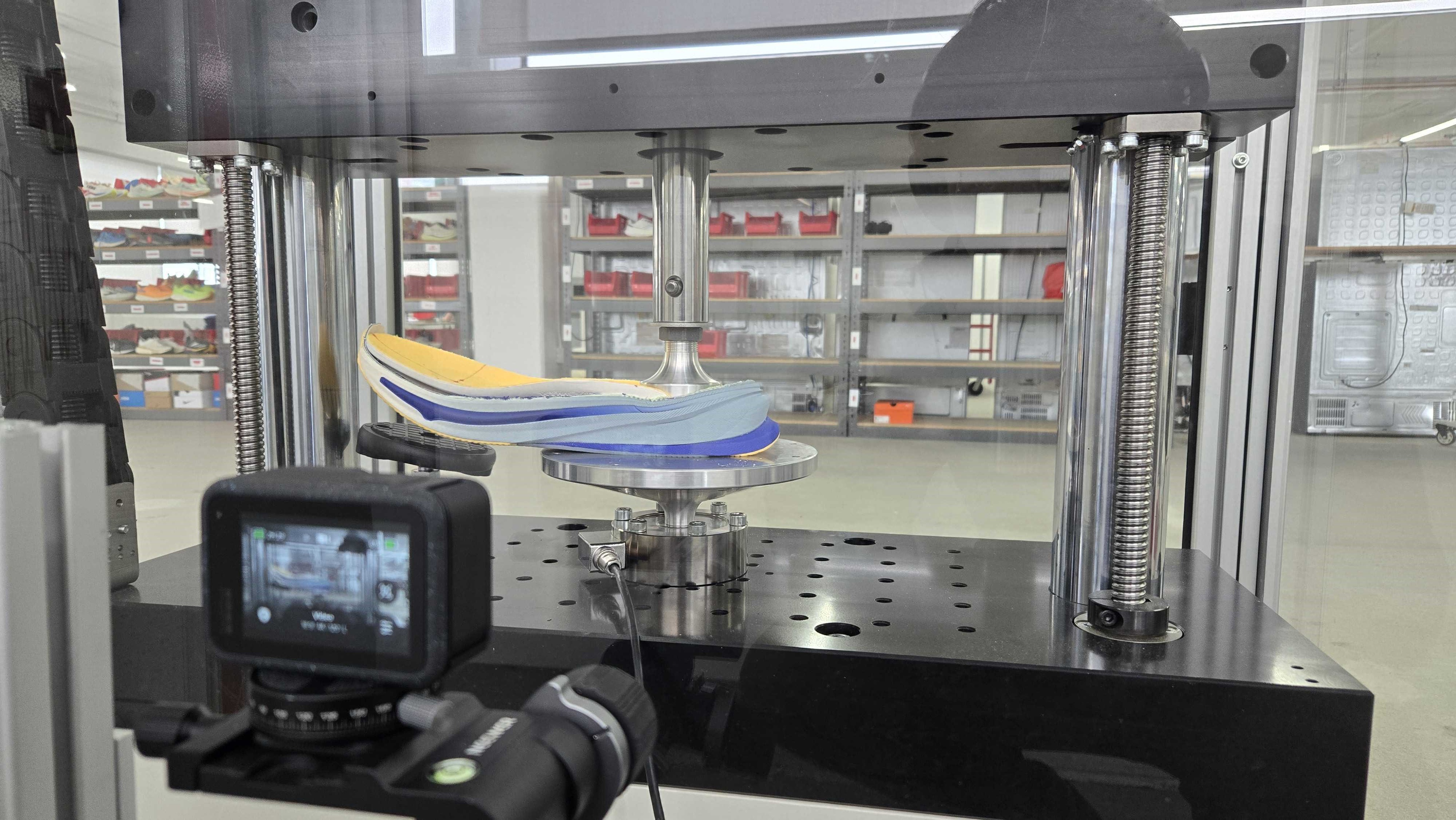
The shoe is on the heavier side, so it feels less agile than more lightweight trainers like the adidas Adizero Evo SL.
The adidas Supernova Rise has good energy return in the heel. Thanks to its PEBA-EVA blend foam, it has relatively high rebound for a daily trainer. However, it doesn't quite reach the efficiency of super shoes like the adidas Adizero Adios Pro 3.
The forefoot energy return is good, making for a fairly springy toe-off.
The shoe has poor heel cushioning and is especially bad at absorbing impact at higher forces. It's not the most squishy, cushioned ride, making it less suitable for slower recovery runs.
The forefoot cushioning is bad. This means the midsole doesn't absorb a lot of energy, so the underfoot protection is inadequate for forefoot strikers and heavier runners, especially for longer sessions, where the shoe tends to bottom out.
The heel is very firm overall, especially at lower forces. The heel lacks softness, making it less comfortable, especially during longer efforts, but the added stability can be beneficial for maintaining form.
The forefoot is remarkably firm across a range of forces, especially at higher forces. That makes it very stable and controlled under the forefoot, allowing for snappier toe-offs, but it may be too firm for those who prefer a softer feel in the forefoot.

